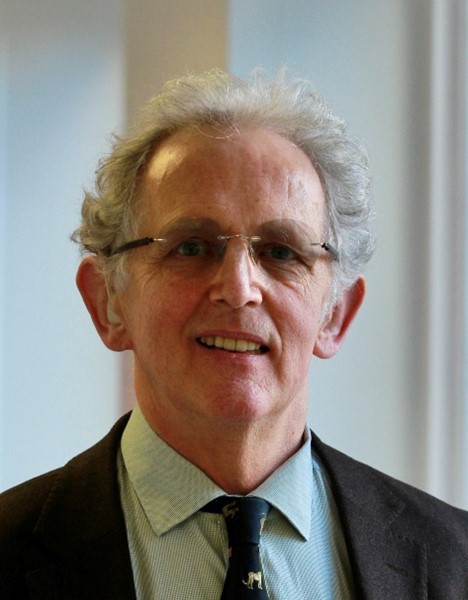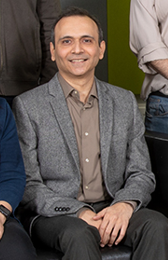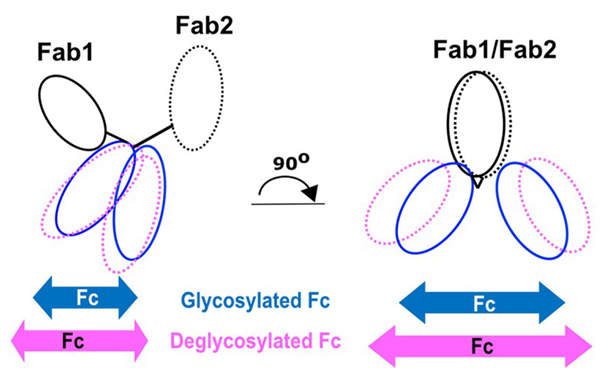
 In humans, immunoglobulin (IgG) is the most common type of antibody found in blood circulation.There are four subclasses of human IgG molecules, which are created by plasma B cells and used by the immune system to identify and neutralise pathogens. Starting from neutron scattering data obtained from SANS2d, Professor Perkins (pictured, right) and Dr Bhatt (pictured, left) developed a new method of atomistic scattering modelling to determine the structure of all four IgG subclasses: IgG1, IgG2, IgG3 and IgG4 and modified forms of these antibodies.
In humans, immunoglobulin (IgG) is the most common type of antibody found in blood circulation.There are four subclasses of human IgG molecules, which are created by plasma B cells and used by the immune system to identify and neutralise pathogens. Starting from neutron scattering data obtained from SANS2d, Professor Perkins (pictured, right) and Dr Bhatt (pictured, left) developed a new method of atomistic scattering modelling to determine the structure of all four IgG subclasses: IgG1, IgG2, IgG3 and IgG4 and modified forms of these antibodies.
By using neutrons, they were able to gain insights that were not available using other techniques such as protein crystallography. Their state-of-the-art molecular dynamics calculations have enabled them to produce full atomistic simulations of the antibody structures in solution. Using Monte Carlo simulations to generate tens of thousands of physically realistic structures, they were then able to determine the best-fit solution structures by comparison of these trial structures with the experimental neutron and X-ray scattering curves. They have also made their findings available in public databases for use by the community.
This joint molecular dynamics and Monte Carlo modelling, developed as part of a collaborative open-source software development project called CCP-SAS, has enabled them to determine the solution structures of all four human IgG subclasses, as well as the high affinity IgG1 cell receptor CD64, and the C5-Fc nanobody which neutralises the COVID-19 virus coat protein. This research has huge potential applications for industry as these antibodies are increasingly used as drugs. Understanding their structures and stability in solution could improve manufacturing processes and expand the applications of therapeutic antibodies.
Their antibody work, which has been featured on multiple journal front covers, showed that the IgG1 structure comprises an asymmetric arrangement of three Fab and Fc subunits, while IgG2 is more symmetric in its appearance, IgG3 has a long central hinge, and IgG4 is more compact in its shape. Their most recent studies have taken the new atomistic modelling approach to new heights by identifying the modest molecular changes in antibody solution structures following the removal of the two conserved glycans that stabilise their structures. One of the drivers for this is the potential for alternative and cheaper manufacturing platforms including bacterial and cell-free systems.

Cartoon showing the outcome of the modelling project on human IgG4 before (blue) and after (pink) the removal of the glycans. Image taken from Spiteri et al, 2024, DOI: 10.1371/journal.pone.0300964
Through their research, not only has the wider scientific community benefitted from a molecular-level insight that cannot be gained by other techniques, but Professor Perkins and Dr Bhatt's modelling methods have led to them working closely with other research organisations and industry, including the Rosalind Franklin Institute and the pharmaceutical giant GSK. They have also delivered training courses at ISIS on these methods. In their more recent work, they have performed computations to determine the structures of collagen and other biological macromolecules, showing the true breadth of their technique's application within the life sciences.
For further information about their work, you can read our science highlight on their study of IgG3, or click the links to view their full publication lists: Professor Stephen Perkins, Dr Jayesh Bhatt.
